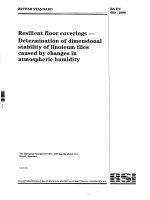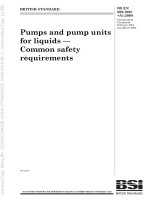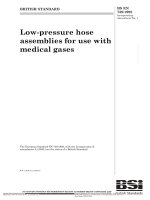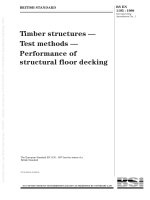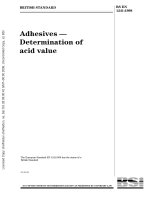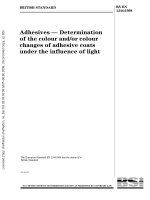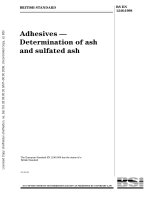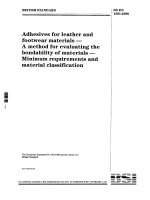Bsi bs en 00710 1998
Bạn đang xem bản rút gọn của tài liệu. Xem và tải ngay bản đầy đủ của tài liệu tại đây (802.55 KB, 66 trang )
BRITISH STANDARD
Safety requirements for
foundry moulding and
coremaking machinery and
plant and associated
equipment
The European Standard EN 710 : 1997 has the status of a
British Standard
ICS 25.120.30
NO COPYING WITHOUT BSI PERMISSION EXCEPT AS PERMITTED BY COPYRIGHT LAW
|
|
|
|
|
|
|
|
|
|
|
|
|
|
|
|
|
|
|
|
|
|
|
|
|
|
|
|
|
|
|
|
|
|
|
|
|
|
|
|
|
|
|
|
|
|
|
|
|
|
|
|
|
|
|
|
|
|
|
|
|
|
|
|
|
|
|
|
|
|
|
|
|
|
|
|
|
|
|
|
|
|
|
|
|
|
|
|
|
|
|
|
|
|
|
|
|
|
|
|
|
|
|
|
|
|
|
|
|
|
|
|
|
|
|
|
|
|
|
|
|
|
|
|
|
|
|
|
|
BS EN
710 : 1998
BS EN 710 : 1998
National foreword
This British Standard is the English language version of EN 710 : 1997.
The UK participation in its preparation was entrusted by Technical Committee
MCE/3 Safeguarding of machinery, to Subcommittee MCE/3/10, Foundry
machines Ð Safety, which has the responsibility to:
± aid enquirers to understand the text;
± present to the responsible European committee any enquiries on the
interpretation, or proposals for change, and keep the UK interests informed;
± monitor related international and European developments and promulgate
them in the UK.
A list of organizations represented on this committee can be obtained on request to
its secretary.
Cross-references
The British Standards which implement international or European publications
referred to in this document may be found in the BSI Standards Catalogue under the
section entitled `International Standards Correspondence Index', or by using the
`Find' facility of the BSI Standards Electronic Catalogue.
Compliance with a British Standard does not of itself confer immunity
from legal obligations.
Summary of pages
This document comprises a front cover, an inside front cover, the EN title page,
pages 2 to 62, an inside back cover and a back cover.
This British Standard, having
been prepared under the
direction of the Engineering
Sector Board, was published
under the authority of the
Standards Board and comes into
effect on 15 January 1998
BSI 1998
ISBN 0 580 28911 7
Amendments issued since publication
Amd. No.
Date
Text affected
EN 710
EUROPEAN STANDARD
NORME EUROPÊENNE
EUROPẰISCHE NORM
August 1997
ICS 25.120.30
Descriptors: Moulding equipment, foundry equipment, safety of machinery, dangerous machines, safety requirements, accident prevention,
hazardous areas, hazards, safety measures, safety devices, verification, marking, technical notices
English version
Safety requirements for foundry moulding and coremaking
machinery and plant and associated equipment
Prescriptions de seÂcurite applicables aux machines
et chantiers de moulage et de noyautage en
fonderie et aÁ leurs eÂquipements annexes
Sicherheitsanforderungen an Gieûereimaschinen
und -anlagen der Form- und Kernherstellung und
dazugehoÈrige Einrichtungen
This European Standard was approved by CEN on 1997-08-02. CEN members are
bound to comply with the CEN/CENELEC Internal Regulations which stipulate the
conditions for giving this European Standard the status of a national standard
without any alteration.
Up-to-date lists and bibliographical references concerning such national standards
may be obtained on application to the Central Secretariat or to any CEN member.
This European Standard exists in three official versions (English, French, German).
A version in any other language made by translation under the responsibility of a
CEN member into its own language and notified to the Central Secretariat has the
same status as the official versions.
CEN members are the national standards bodies of Austria, Belgium, Czech
Republic, Denmark, Finland, France, Germany, Greece, Iceland, Ireland, Italy,
Luxembourg, Netherlands, Norway, Portugal, Spain, Sweden, Switzerland and
United Kingdom.
CEN
European Committee for Standardization
Comite EuropeÂen de Normalisation
EuropaÈisches Komitee fuÈr Normung
Central Secretariat: rue de Stassart 36, B-1050 Brussels
1997 CEN Ð All rights of exploitation in any form and by any means reserved worldwide for CEN national
Members
Ref. No. 710 : 1997 E
Page 2
EN 710 : 1997
Foreword
Page
This European Standard has been prepared by
Technical Committee CEN/TC 202, Foundry machinery,
the secretariat of which is held by DIN.
This European Standard shall be given the status of a
national standard, either by publication of an identical
text or by endorsement, at the latest by February 1998,
and conflicting national standards shall be withdrawn
at the latest by February 1998.
For relationship with EU Directives, see informative
annex ZA, which is an integral part of this standard.
According to the CEN/CENELEC Internal Regulations,
the national standards organizations of the following
countries are bound to implement this European
Standard: Austria, Belgium, Czech Republic, Denmark,
Finland, France, Germany, Greece, Iceland, Ireland,
Italy, Luxembourg, Netherlands, Norway, Portugal,
Spain, Sweden, Switzerland and the United Kingdom.
Contents
Foreword
0
Introduction
1
Scope
2
Normative references
3
Definitions
3.1 Moulding
3.2 Coremaking
3.3 Associated equipment
3.4 Knock-out equipment
3.5 Modes of operation
4
Hazards
5
Safety requirements and measures
5.1 General
5.2 Conditioning and reclamation
equipment
5.3 Moulding machinery and plants
5.4 Coremaking machinery and plants
5.5 Knock-out equipment
Page
2
3
3
3
5
5
5
6
6
7
7
7
7
10
17
27
31
5.6 Handling of machines and heavy
component parts for maintenance and
repair
5.7 Fire/explosion when coating moulds
and cores
5.8 Maintenance and setting activities
6
Verification of the safety requirements
and preventative measures according
to clause 5
6.1 Safety systems
6.2 Electrical safety
6.3 Pressure release of dust explosions
6.4 Explosiveness of coal dust or coal
dust substitutes
6.5 Stress analysis
6.6 Airborne substances generated during
operation
6.7 Noise
6.8 Vibration
6.9 Safety marking
7
Information for use
7.1 Marking
7.2 Technical data and description for
safety
7.3 Operation manual
7.4 Maintenance manual
Annexes
A
(normative) Examples of solutions
for 3.8 of EN 292-2 Preventing
hazards from hydraulic and
pneumatic equipment
B
(informative) Main components of
hazardous gases and fumes during the
application of moulding material
binders and coatings for cores and
moulds
C
(normative) Hazardous areas and
corresponding preventative measures
ZA (informative) Clauses of this European
Standard addressing essential
requirements or other provisions of
EU Directives
32
32
33
35
35
35
35
35
35
35
35
35
35
35
35
35
36
36
37
57
59
62
BSI 1998
Page 3
EN 710 : 1997
0 Introduction
2 Normative references
This European standard is a type C standard as defined
in EN 292-1.
The machinery concerned and the extent to which
hazards are covered is indicated in the scope of this
standard.
In addition, machinery shall comply as appropriate
with EN 292-1 and EN 292-2 for hazards which are not
covered by this standard and if applicable the other
standards referenced in clause 2.
This European Standard incorporates, by dated or
undated reference, provisions from other publications.
These normative references are cited at the
appropriate places in the text and the publications are
listed hereafter. For dated references, subsequent
amendments to or revisions of any of these
publications apply to this European Standard only
when incorporated in it by amendment or revision. For
undated references the latest edition of the publication
referred to applies.
1 Scope
EN 286-1 : 1991
This standard specifies safety requirements to be met
by the manufacturer for machines and plant used in
foundries for the production of castings in disposable
moulds. It takes into account the foreseeable
significant hazards due to design, construction and
installation that may occur during commissioning,
operation, maintenance and decommissioning. It
specifies preventative measures and verification means
for the elimination or reduction of these hazards. It
specifies requirements for information to be provided
by the manufacturer to the user on safe operation and
maintenance.
This standard applies to the following equipment:
± machinery and plant constructed to condition
and/or reclaim foundry sands;
± moulding machinery and plants;
± coremaking machinery and plants;
± knock-out equipment;
± other directly associated equipment.
The foreseeable significant hazards covered are listed
in clause 5 and include:
± mechanical hazards, movement of machinery and
workpieces, ejection of material, of liquids and
gases, inadequacy of the mechanical strength;
± explosion, fire, exothermic reactions;
± contact with hot parts, gases and flames;
± noise and vibration;
± thermal heat radiation and conduction;
± harmful by-products, poisoning, pollution of
operators' breathing air.
This standard applies to equipment which is placed on
the market after the date of issue of this standard.
This standard does not cover the safety requirements
for wax- and lost foam pattern production and wax
removal equipment and drying ovens.
This standard does not apply to crane installations,
winches, continuous conveyors or handling systems
which could be an integral part of the above
equipment.
The standard does not cover dust reduction equipment.
EN 292-1 : 1991
EN 292-2 : 1991
Simple unfired pressure vessels
designed to contain air or
nitrogen
Part 1: Design, manufacture and
testing
Safety of machinery Ð Basic
concepts, general principles for
design
Part 1: Basic terminology,
methodology
Safety of machinery Ð Basic
concepts, general principles for
design
Part 2: Technical principles and
specifications
Safety of machinery Ð Basic
concepts, general principles for
design
Part 2: Technical principles and
specifications
Safety of machinery Ð Safety
distances to prevent danger
zones being reached by the upper
limbs
Safety of machinery Ð
Minimum distances to avoid
crushing of parts of the human
body
Safety of machinery Ð
Emergency stop equipment,
functional aspects Ð Principles
for design
Safety of machinery Ð
Terminology
Safety of machinery Ð
Interlocking devices with and
without guard locking Ð General
principles and specifications for
design
Safety of machinery Ð Electrical
equipment of machines
Part 1: General requirements
www.bzfxw.com
BSI 1998
EN 292-2/A1 : 1995
EN 294 : 1992
EN 349 : 1993
EN 418 : 1992
ENV 1070
EN 1088 : 1995
EN 60204-1 : 1992
Page 4
EN 710 : 1997
EN 61310-1 : 1994
prEN 574 : 1991
prEN 614-1 : 1994
prEN 746-2 : 1992
prEN 953 : 1992
prEN 954-1 : 1996
prEN 982 : 1995
prEN 983 : 1994
prEN 999 : 1993
Safety of machinery Ð
Indicating, marking and
actuating principles Ð
Part 1: Visual, audible and
tactile signals
Safety of machinery Ð
Two-hand control device
Safety of machinery Ð
Ergonomic design principles
Part 1: Terminology and general
principles
Industrial thermoprocessing
equipment Ð
Part 2: Safety requirements for
combustion and fuel handling
systems
Safety of machinery Ð Guarding
of machinery Ð Fixed and
movable guards
Safety of machinery Ð Safety
related parts of control systems
Part 1: General principles for
design
Safety of machinery Ð Safety
requirements for fluid power
systems and their components Ð
hydraulics
Safety of machinery Ð Safety
requirements for fluid power
systems and their components Ð
pneumatics
Safety of machinery Ð
Hand/arm speed; approach speed
of parts of the body for the
positioning of safety devices
prEN 1005-2 : 1995
(2nd revision)
Safety of machinery Ð Human
physical performance
Part 2: Manual handling of
machinery and component parts
of machinery
prEN 1093-1 : 1993 Safety of machinery Ð
Evaluation of the emission of
airborne hazardous substances
Part 1: Selection of test methods
prEN 1265 : 1993
Noise test code for foundry
machines and equipment
prEN 1539 : 1994
Dryers and ovens in which
flammable substances are
released from coating
materials Ð Safety requirements
prEN 1921 : 1995
Industrial automation
systems Ð Safety of integrated
manufacturing systems Ð Basic
requirements
prEN 50100-1 : 1992 Safety of machinery Ð
Electro-sensitive protective
devices
Part 1: Specifications for general
requirements
ISO 6184-1 : 1985
Explosion protection systems
Part 1: Determination of
explosion indices of combustible
dusts in air
ISO/TR 11688-1 :
Acoustics Ð Recommended
1995
practice for the design of
low-noise machinery and
equipment
Part 1: Planning
www.bzfxw.com
BSI 1998
Page 5
EN 710 : 1997
3 Definitions
For the purposes of this standard, the definitions given in ENV 1070 apply.
Other terms, definitions and characteristics are as follows:
Term/Type of machine
3.1 Moulding
3.1.1 Moulding machinery
Definition/Description, Character, Functions
Machines used to make sand moulds. There are various machinery types
which compact granular moulding materials including:
± jolt moulding machines (compaction by jolting the moulding machine
deck);
± squeeze moulding machines (compaction by squeezing the pattern
equipment and the moulding sand together);
± jolt and squeeze moulding machines;
± shoot-/blow- and squeeze moulding machines;
± impulse moulding machines (the moulding sand is compacted by a
compression wave which acts on the top of the sand fill);
± air-flow-squeeze moulding machines (similar to impulse-moulding
machines, except that the compressed air escapes through nozzles in the
pattern plate);
± dynamic squeeze moulding machines (compensating pressure squeeze
pistons act on the top of the sand fill);
± suction and squeeze moulding machines (the pressure differential
between the moulding box and the pattern draws in the moulding sand);
± vacuum-moulding machines (unbonded sand is compacted by vacuum);
± sand slingers (the moulding sand is flung into the moulding box by the
centrifugal force of a rotating wheel).
All the equipment used to make ready-to-pour sand moulds. A moulding
plant consists of moulding stations (automatic moulding machines for
complete moulds) or several moulding machines (moulding group) that
produce the moulding parts separately.
www.bzfxw.com
3.1.2 Moulding plant
3.1.3 Disposable mould
3.2 Coremaking
3.2.1 Coremaking machinery
It may also include lines for core setting, mould closing, weighting or
clamping, pouring, cooling, knocking-out of the mould parts and emptying of
the boxes as well as integral transfer systems linking the various stations
and lines.
A mould that is destroyed to remove the casting.
Machines used to make solid and/or hollow cores.
Coremaking machinery is classified into core shooters and core blowers.
The principle of core shooting is to rapidly expand compressed air via the
sand cylinder into the sand. The cylinder is equipped with openings and a
provision for sandfilling (indirect working).
The sand is then conveyed along in the airstream.
3.2.2 Coremaking plant
The principle of core blowing is to transport the sand by means of
compressed air into the corebox (direct working). The sand is conveyed
along in front of the compressed air.
All the equipment used to make ready-to-use cores (single cores and/or core
assemblies).
A plant may consist of a sand preparation plant, coremaking machine,
equipment for handling, deflashing, assembling, coating and drying of cores.
BSI 1998
Page 6
EN 710 : 1997
Term/Type of machine
3.3 Associated equipment
3.3.1 Conditioning equipment
± Sand mixers and mills
Definition/Description, Character, Functions
Equipment and plant used to prepare ready-to-use bonded sands, including
equipment for its conveyance and storage.
± Machines for batch mixing (blending, coating, kneading) of moulding or
core sand with bonding agents, water and complementary mould material
additions.
The machines are provided with rotating paddles and/or milling rollers
and fast rotating paddles for the aeration of the material. Typically,
machines consist of a circular container in which are mounted rotating
ploughs and/or mill wheels (mullers).
± Machines for continuous mixing.
± Sand aerators
± Spike disintegrators
± Installations for the storage
and pneumatic conveyance of
coal dust or coal dust
substitutes and their mixtures
with bonding agents
± Sand dryers and heaters
3.3.2 Reclamation equipment
± Sand lump crushers
± Thermal reclamation ovens
± Mechanical reclamation
machines
± Magnet separators
± Screening installations
3.3.3 Gassing equipment
3.4 Knock-out equipment
± Punch-out equipment
± Rotary knock-out and/or
cooling drum
These are machines in which the contents are continuously mixed and
conveyed to the discharge gate.
Machines used to aerate the mixed sand such as belt aerators (conveyor belt
with impact bars) or wheel aerators (drum with impact bars).
Disintegrators with a horizontal or a vertical rotating axis. Used and lump
sand is conveyed axially to the disintegrator wheels.
The disintegrator wheels are normally provided with projections and rotate
in opposite directions.
Silos and pipework that are filled pneumatically with such material and by
which the material is supplied pneumatically to the next operation (e.g. sand
mixers).
www.bzfxw.com
Plant consisting of a heating system and/or subsequent cooling equipment.
Equipment and plant including storage and conveying facilities used for the
reclamation of used sands by mechanical and/or thermal processing means.
Machines used to break down lumps of used sand by mechanical means.
Machines used to destroy the binder by thermal means.
Machines used to destroy the binder by mechanical means.
Machines used to separate ferro-magnetic material from the used sand.
Machines used to classify used sands (this may be achieved by vibration,
rotation or other means).
Equipment used to produce and/or condition reactive gases and supply them
to the gassing station or into the sand mixture. Typical processes are:
binder system
reactive gas
±
±
±
±
CO2
amine
SO2
methylformate
silicate
urethane
furane resin/peroxide or epoxy resin/peroxide
alkaline resin
Equipment used to separate castings from the moulding box and/or the
mould and/or cores from castings.
Equipment used to separate the mould and castings from the moulding box
by vertical or horizontal movement of a punch-out piston.
A rotating or reciprocating cooling drum through which sand and castings
are conveyed and separated. The rolling movement of the castings breaks up
the lumps of sand as the drum rotates.
BSI 1998
Page 7
EN 710 : 1997
Term/Type of machine
± Knock-out grid
± Knock-out tray
3.5 Modes of operation
3.5.1 Setting
3.5.2 Manual
3.5.3 Semi-automatic
3.5.4 Automatic
Definition/Description, Character, Functions
A grid provided with a vibrating facility for the separation of moulding sand
from the moulding box and/or from the casting.
Oscillating conveyor for the separation of casting and moulding material.
All the steps within a process can be initiated separately and manually in
any sequence.
Example: mould changing or pattern changing.
All the steps within a process can be initiated separately in the sequence of,
or out of the sequence of, the programme (e.g. termination of a moulding
cycle or continuation of a moulding cycle for testing or fault detection).
Each cycle or part of a cycle is initiated manually and then proceeds to
completion in the pre-determined sequence.
Each cycle is initiated by the previous cycle (e.g. continuous operation).
4 Hazards
Significant hazards are those where the risk of being
injured through dangerous movements exists
(e.g. squeeze and shear points) or sources of hazard
occur (e.g. hazardous materials, conduction and
radiation of heat, ejection of metal, explosion, ignition
of hydraulic fluids, ejection of sand under pressure,
unintended unclamping of elevated parts such as
moulding boxes or shooting heads).
An assessment of the foreseeable risks arising from the
use of the equipment was carried out when this
standard was prepared.
Significant hazards have been condensed in the Scope
and have been detailed in the table in clause 5.
The manufacturer shall take into account the
requirements of EN 292-2 and EN 60204-1. The safety
distances shall be in accordance with EN 294
and EN 349.
NOTE 1. Every attempt has been made in this standard to identify
all of the relevant risks. However manufacturers should ensure
through their own risk assessment that there are no additional
risks not covered by this standard. Where additional risks are
present, it is recommended that EN 292-1 and EN 292-2 together
with the A and B standards are used as a basis for dealing with
these additional risks.
NOTE 2. The manufacturer assumes that operators are properly
trained and instructed in the intended use of the machine and in
the functioning of any safeguarding.
www.bzfxw.com
5 Safety requirements and measures
The following subclauses detail the hazards, hazardous
situations and preventative measures relevant to the
classes of machinery detailed in 5.2 to 5.5.
Annex C gives examples of the areas on the particular
machinery class which are considered to be hazardous
and the likely means that could be used to counteract
these hazards. Annex A exemplifies further specific
information on the type of preventative measure to be
used for certain machinery classes and should be
considered in conjunction with the preventative
measures specified in 5.2 to 5.5.
Where, for clarity, an example of a safety measure is
given in the text this shall not be considered as the
only possible solution. Any other solution leading to
the same risk reduction is permissible if an equivalent
level of safety is achieved.
5.1 General
Machines and equipment shall be designed to eliminate
or reduce risks. The purpose of this standard is to
assist manufacturers to design their machines and
equipment so that the risks arising from their intended
use are reduced or eliminated.
BSI 1998
Tables 5.2 to 5.8 specify the preventative measures
required for the different types of machinery and plant
during consideration of the significant hazards and
risks involved in their operation either:
Column 4:
and/or
Column 5:
by reference to EN 292
by reference to preventative measure.
Unless otherwise stated, the preventative measures
assigned to the identified hazardous situations shall be
provided in a cumulative manner.
The tables also reference the appropriate verification
means in column 6.
5.1.1 Fixed guards
These guards shall be designed in accordance with
EN 292-2, EN 294 and prEN 953.
These guards shall also be designed to contain
processed materials, fluids or parts that can
foreseeably be ejected, or to contain emissions of
substances or noise if applicable.
Where practical, these guards shall be fixed to the
machine structure.
If floor mounted, these guards shall be securely fixed
and have a minimum height of 1,4 m and a sufficient
distance from the danger zone (see EN 294 : 1992,
table 1).
Page 8
EN 710 : 1997
The installation of fixed covers is sufficient for
safeguarding danger zones when there is no need to
reach in or walk in during normal operation and/or for
maintenance and setting activities or troubleshooting.
5.1.2 Movable guards
5.1.2.1 Detection and monitoring
Movable guards in danger zones with fixed cycle
intervention or access (e.g. during loading and
unloading of parts), set-up activities, periodical manual
cleaning or spraying and troubleshooting, shall
incorporate guard interlocking with dual detection and
monitoring. Dual detection may be by two separate
switches or by a single switch and detection of guard
lock position (see EN 1088).
Where the guard is open, the drive power supply for
the relevant hazardous movements shall be positively
disconnected.
5.1.2.2 Interlocking guard with guard locking
An interlocking guard with guard locking effective
within the hazardous period shall be used when the
stopping time of the hazardous movement is greater
than the access time of a person in reaching the
danger zone.
5.1.2.3 Closing the guards
Closing the guards shall not initiate operation of
hazardous movements. If movement was interrupted by
opening of an interlocked danger zone guard, the
restart shall be performed by actuation from outside
the guard.
5.1.2.4 Power operated guards
Power operated guards shall not create a trap. Either
the power provided shall be insufficient to cause injury
in the event of trapping, or the guard shall be provided
with a safety trip device to prevent injury.
Actuation of the safety trip device shall stop or reverse
the direction of movement of the movable guard.
5.1.3 Electro-sensitive protective devices (ESPD)
If electro-sensitive protective devices (see prEN 50100-1
and prEN 50100-2) are used then the following
requirements shall be met:
a) the control system of the machine shall be able to
interrupt the hazardous movement in time when it
receives the output signal from such a protective
device;
b) they shall switch on if the control system of the
machine is connected,
c) they shall be tested at each machine cycle;
d) they shall not act as control devices;
e) they shall not be adjustable, neither in the vertical
nor in the horizontal direction;
f) they shall be interlocked with the hazardous
movements of the machine;
g) the output-signals of such devices shall be
independent of the electronic control system of the
machine;
h) the protective field of such devices shall cover
the access area;
i) they shall be positioned so that persons cannot
remain between the protective field of the device
and the danger zone and initiate a machine cycle;
j) their position, in relation to the danger zone, shall
take into account the machine stopping time, the
approach speed of the operator and the initiation
time of the device (see prEN 999).
5.1.4 Two-hand control devices
If two-hand control devices (see prEN 574) are used,
then the following requirements shall be met:
a) the control system of the machine shall be able to
interrupt the hazardous movement in time if one
actuator of this device is released;
b) they shall comply with type IIIB of prEN 574;
c) they shall be interlocked with the hazardous
movements of the machine;
d) their output-signals shall be independent of the
electronic control system of the machine;
e) their position, in relation to the danger zone, shall
take into account the machine stopping time, the
approach speed of the operator and the initiation
time of the device (see prEN 999).
www.bzfxw.com
5.1.5 Several persons at the same time occupied
at hazardous points
When machinery and plant require frequent
intervention (i.e. for feeding and/or removing of parts)
and if several persons are occupied at the same time at
hazardous points of machinery and plant, each person
shall be protected (e.g. by movable guards, two-hand
control devices or electro-sensitive protective devices)
so that they will not be mutually endangered during
that intervention.
5.1.6 Control systems
Where access to the danger zone is required during
normal operation (EN 292-2 : 1991, 4.1.3) the safety
related control systems of the equipment, including the
interlocking devices, shall be in accordance with
category 4 of prEN 954-1 : 1996.
Where access to the danger zone is not required during
normal operation of the machinery
(EN 292-2 : 1991, 4.1.2) but foreseeable access is
needed for maintenance and setting activities,
troubleshooting or cleaning the safety related control
systems of the equipment including the interlocking
devices, shall be in accordance with at least category 2
of prEN 954-1 : 1996. The hydraulic and pneumatic
equipment shall comply with at least category 1.
BSI 1998
Page 9
EN 710 : 1997
If these tasks can only be performed whilst the
protective device is switched off, lockable mode
selection switches shall be provided for the
disconnection of the protective device and the
simultaneous transition to setting mode. If the actuator
is released any hazardous movements shall be
interrupted immediately. Unintentional movements of
dangerous parts shall be prevented. When reduced
speed of such movements is used to permit
maintenance and setting activities the control system in
this mode shall comply with category 4 of
prEN 954-1 : 1996.
When there are electronic components within the
machine control system, the interlocking of the safety
functions (emergency stop, interlockings,
electrosensitive protective devices or two-hand control
devices) shall be independent of the electronic control
system of the machine. If the monitoring is achieved
by an electronic system then the signals shall be
connected to an electronic control system by separate
input modules.
BSI 1998
Control systems for automatically operated machines
and units shall provide for matching emitted signals
with the sequence according to the programme.
Succeeding steps shall only be initiated after the
previous steps are finished.
Limit switches within controls shall be arranged or
installed so that no unintended start can be initiated
either by unintended actuation of any mechanical limit
switches or by the approach of metal parts to
electrosensitive limit switches.
The machine shall be so designed that during
foreseeable operation it will stop immediately at any
point in its cycle when an emergency stop
(see EN 418) is activated or a safety function or device
(see EN 1088) has become inoperative.
5.1.7 Manual handling of loads
For the manual handling of loads (e.g. flasks, setting,
removal of cores or patterns, maintenance)
see EN 292-2, prEN 614-1 and prEN 1005-2.
Page 10
EN 710 : 1997
5.2 Conditioning and reclamation equipment
5.2.1 Preventative measures against injuries due to mechanical hazards
5.2.1.1 Sand mixers, mills and coolers
Hazard
Hazardous
situation
Risk/Mode of
operation
1
2
Crushing/
shearing/
Drawing-in
Movement of the
mixing and milling
tools within the
mixing or cooling
plate or trough
Movement of the
mixing and milling
tools during
rotation when they
are being removed
or reinserted into
the mixing plate;
Preventative
measures according
to relevant sections
of EN 292
Particular preventative
measures
Verification
means ref.
clause 6
3
4
5
6
Injury to hands
when sampling
from above or at
the discharge;
cleaning of
discharge from
outside; cleaning of
screw of
continuous mixers
3.22.1/Part 1
ref. clauses 5.1.1, 5.1.2
(Fixed guard)
and 5.1.6
3.22.5/Part 1
(Interlocking guard
with guard locking)
6.2.2/Part 2 (Provisions
for isolation and
energy dissipation)
Injury to arms, head 3.23.1/Part 1
and body when
(Interlocking device)
touching tools
3.8/Part 2 (Preventing
hazards from
pneumatic and
hydraulic equipment)
Unexpected gravity
fall of the raised
swivel arm
ref. clause 5.1.6
Interlocking of the movement
of tools with the lifting
movement of the swivel arm
6.1.1/6.1.2
6.1.1/6.1.2
6.1.1
6.1.1
Means to prevent the falling of
the swivel arm: Spring-loaded
jacks or lock bolts, check valve
or control valve for the
swing-out components that
lock automatically when there
is a pressure drop or release
Examples for 3.8/Part 2
see annex A
Crushing/
shearing
Where there is the
possibility of entry
into the mixer/mill/
cooler
Danger to persons
working inside
(cleaning or
maintenance) from
unexpected start-up
NOTE. During
maintenance,
several employees
may be working on
the conditioning/
reclaiming
equipment.
3.22.5/Part 1
(Interlocking guard
with guard locking)
3.7.2/Part 2 (Safety
against spontaneous
restart)
3.7.3 to 3.7.6 and
3.7.10/Part 2 (Safety
against hazards due to
failure of the control
or malfunction if
applicable in a
cumulative way)
6.2.2/Part 2 (Provisions
for isolation and
energy dissipation)
ref. clauses 5.1.1, 5.1.2
and 5.1.6
Disconnecting switch for the
mixer/mill/cooler with lock-off
6.1.1/6.1.2
Access door shall be secured
against unintended closing and
locking
6.1.1
Permanent and clear warning
sign `danger zone' and
additional sign `before entry,
the mixer shall be shut-off and
secured against restart by the
person(s) who enter(s)'
6.1.2
6.9/6.1.1
See prEN 1005-2
6.1.1
Neglected
ergonomic
principles
Manual loading
Increased fatigue
3.6/Part 2 (Observing
ergonomic principles)
Noise
Effects of
peripheral work
Loss of awareness
3.2/Part 2 (Making
Drives as silent as possible,
machines inherently
rpm as low as possible
safe by virtue of ...)
(see ISO/TR 11688-1 : 1993)
3.6.3/Part 2 (Avoiding
as far as possible
noise, vibration,
thermal effects)
4/Part 2 (Safeguarding)
6.7
BSI 1998
Page 11
EN 710 : 1997
5.2 Conditioning and reclamation equipment
5.2.1 Preventative measures against injuries due to mechanical hazards
5.2.1.1 Sand mixers, mills and coolers (concluded)
Hazard
Hazardous
situation
Risk/Mode of
operation
Preventative
measures according
to relevant sections
of EN 292
Particular preventative
measures
Verification
means ref.
clause 6
1
2
3
4
5
6
Interference
with speech
communication
and acoustic
signals
Effects of
peripheral work
Danger of accident
3.2/Part 2 (Making
Drives as silent as possible,
machines inherently
rpm as low as possible
safe by virtue of ...)
(see ISO/TR 11688-1 : 1993)
3.6.3/Part 2 (Avoiding
as far as possible
noise, vibration,
thermal effects)
4/Part 2 (Safeguarding)
6.7
Preventative
measures according
to relevant sections
of EN 292
Particular preventative
measures
Verification
means ref.
clause 6
5.2.1.2 Sand aerators
Hazard
Hazardous
situation
Risk/Mode of
operation
1
2
3
4
5
6
Crushing/
shearing
The discharge point Injury to hands or
and the entry point upper/lower limbs
especially of the
aerating belt or
aerating drum to
enclosure creates a
pinch point
3.22.1/Part 1
(Fixed guard)
Prevent access into the danger
zone by provision of a suitable
guard.
ref. clauses 5.1.1, 5.1.2
and 5.1.6
6.1.1
When maintenance
is being carried out
3.22.5/Part 1
(Interlocking guard
with guard locking)
6.2.2/Part 2 (Provisions
for isolation and
energy dissipation)
6.1.1
6.1.1/6.1.2
Noise
Effects of
peripheral work
Hearing loss, loss
of awareness
3.2/Part 2 (Making
machines inherently
safe by virtue of ...)
3.6.3/Part 2 (Avoiding
as far as possible
noise, vibration,
thermal effects)
4/Part 2 (Safeguarding)
Drives as silent as possible,
rpm as low as possible,
isolation of structure borne
noise of aerator casing against
the drive, deadening of the
aerator casing
(see ISO/TR 11688-1 : 1993)
6.7
Interference
with speech
communication
and acoustic
signals
Effects of
peripheral work
Danger of accident
3.2/Part 2 (Making
machines inherently
safe by virtue of ...)
3.6.3/Part 2 (Avoiding
as far as possible
noise, vibration,
thermal effects)
4/Part 2 (Safeguarding)
Drives as silent as possible,
rpm as low as possible,
isolation of structure borne
noise of aerator casing against
the drive, deadening of the
aerator casing
(see ISO/TR 11688-1 : 1993)
6.7
BSI 1998
Page 12
EN 710 : 1997
5.2 Conditioning and reclamation equipment
5.2.1 Preventative measures against injuries due to mechanical hazards
5.2.1.3 Spike disintegrators (disintegrators for used sand)
Hazard
Hazardous
situation
Risk/Mode of
operation
Preventative
measures according
to relevant sections
of EN 292
Particular preventative
measures
Verification
means ref.
clause 6
1
2
Crushing/
shearing
Openings in the
machine body could
create a pinch point
during wheel
movement
3
4
5
6
If during
inspection/cleaning/
trouble-shooting
there is unintended/
unexpected start-up
or the covers are
opened before the
wheel has stopped
then injuries to the
operator could
result
3.22.5/Part 1
ref. clauses 5.1.1, 5.1.2
(Interlocking guard
and 5.1.6
with guard locking)
6.2.2/Part 2 (Provisions
for isolation and
energy dissipation)
6.1.1
Noise
as 5.2.1.2
as 5.2.1.2
as 5.2.1.2
as 5.2.1.2
6.7
Interference
with speech
communication
and acoustic
signals
as 5.2.1.2
as 5.2.1.2
as 5.2.1.2
as 5.2.1.2
6.7
6.1.1/6.1.2
5.2.1.4 Sand lump crushers
Hazard
Hazardous
situation
Risk/Mode of
operation
Preventative
measures
according to
relevant sections
of EN 292
Particular preventative
measures
Verification
means ref.
clause 6
1
2
3
4
5
6
Crushing/
shearing/impact
Openings provided
in the machine
body for
inspection,
maintenance of
tools, cleaning
Danger from crusher
movement if there is
unexpected start-up or
if the hinged covers
are opened before the
crusher has stopped.
Ejection of lumps
3.22.5/Part 1
(Interlocking guard
with guard locking)
6.2.2/Part 2
(Provisions for
isolation and energy
dissipation)
ref. clauses 5.1.1, 5.1.2
and 5.1.6
6.1.1
Noise
as 5.2.1.2
as 5.2.1.2
as 5.2.1.2
Drives as silent as possible,
deadening of the crusher
casing
(see ISO/TR 11688-1 : 1993)
6.7
Interference
with speech
communication
and acoustic
signals
as 5.2.1.2
as 5.2.1.2
as 5.2.1.2
Drives as silent as possible,
deadening of the crusher
casing
(see ISO/TR 11688-1 : 1993)
6.7
Vibration
Machinery
vibration may
have effects on
the adjoining
work places
Stress to human joints,
nerves and blood
vessels due to whole
body vibration
Isolation of vibration at the
installation of sand lump
crushers producing vibrations
6.8
6.1.1/6.1.2
BSI 1998
Page 13
EN 710 : 1997
5.2 Conditioning and reclamation equipment
5.2.1 Preventative measures against injuries due to mechanical hazards
5.2.1.5 Screening equipment
Hazard
Hazardous
situation
Risk/Mode of
operation
Preventative
measures according
to relevant sections
of EN 292
Particular preventative
measures
Verification
means ref.
clause 6
1
2
3
4
5
6
Drawing-in/
trapping/
shearing
Pinch points are
created if the doors
are opened during
rotation of the
equipment or doors
are not closed
before the
equipment starts
Injury to the
operator during
operation,
maintenance,
cleaning,
troubleshooting
3.22.4/Part 1
(Interlocking guard)
ref. clauses 5.1.1, 5.1.2
and 5.1.6
6.1.1
Particular preventative
measures
Verification
means ref.
clause 6
5.2.1.6 Magnetic separators
Hazard
Hazardous
situation
Risk/Mode of
operation
Preventative
measures according
to relevant sections
of EN 292
1
2
3
4
Stabbing or
puncture
Unprotected
discharge of
ferromagnetic
material from the
magnetic separator
Danger to eyes and
body
Presence of tramp
metal in the sand,
therefore also
danger when
operating sand
slingers
Crushing/
drawing-in
BSI 1998
Touching of moving Injuries to arms
parts of the
conveyor
5
6
Proper metal separation.
Shielding of separator
discharge without creating
pinch points.
ref. clause 5.1.1
6.1.1/6.1.2
Warning sign requesting eye
protection
6.9
NOTE. The choice of the
magnetic separator depends on
the weight and geometry of the
iron parts to be separated and
either their temperature or
surrounding temperature, the
degree of the alloy, the velocity
of the belt conveyor and - in
case of magnetic-belt
separators - on the lowest
possible distance between the
magnet and the belt conveyor.
There should be no
components of magnetic
material within the affected
space (e.g. metal sheets,
construction parts, idlers).
3.22.1/Part 1
(Fixed guard)
6.1.1/6.1.2
Page 14
EN 710 : 1997
5.2 Conditioning and reclamation equipment
5.2.2 Measures against hazards caused by substances
5.2.2.1 Mixers/mills, disintegrators, sand lump crushers
Hazard
Hazardous
situation
Risk/Mode of
operation
Preventative
measures
according to
relevant sections
of EN 292
Particular preventative
measures
Verification
means ref.
clause 6
1
2
3
4
5
6
Danger from
breathing quartz
dust
4.2.2.1/Part 2
Equipment for dust reduction
6.1.1/6.1.2/
(Functions of guards) are e.g. enclosed charging and 6.6
discharging of sand or material
accompanied with sand,
prevention of spills and leaks,
no gravity fed enclosures
connected to exhaust systems,
possibility for ventilation.
ref. clause 7.2
Inhalation of
Feeding and
fumes and dusts discharging sand
Exothermic
reactions
Feeding and
discharging during
the reclamation of
used sand, mixers
for resin-bonded
mould and core sand
Damage to health
4.2.2.1/Part 2
Local exhaust ventilation
6.1.1/6.1.2/
from airborne
(Functions of guards) ref. clause 7.2
6.6
formaldehyde,
phenol,
Design to avoid the use of
6.1.1
furfurylalcohol both
excessive binder, to provide for
for breathing and for
automatic dosing or enclosed
skin contacts
dosing and to avoid skin
contact
Supply of resin and
hardener which
cause an exothermic
reaction
Fire and explosion
hazard when no
sand in machine or
hoses wrongly
connected
The supply of resin and
6.1.1
hardener shall only be possible
if probes within the equipment
indicate that there is a
sufficient quantity of sand.
Injury to respiratory
tracts from
breathing harmful
gases. Cauterization
because of skin
contact
Connecting hoses shall be
marked and designed to
prevent interchangeability
e.g. with left-hand threads for
hardeners and right-hand
threads for the other materials
(e.g. binders)
NOTE. Continuous conveyors are not covered by the scope of this standard. If continuous conveyors are part of the conditioning and
reclamation plant and their operation creates a particular risk of dust and fumes the relevant preventative measures also apply to this
equipment.
5.2.2.2 Sand dryers and heaters
Hazard
Hazardous
situation
Risk/Mode of
operation
Preventative
measures according
to relevant sections
of EN 292
Particular preventative
measures
Verification
means ref.
clause 6
1
2
3
4
5
6
Explosion
Gas fired equipment Ignition procedure,
control failure, flow
failure
See prEN 746-2
6.1.1/6.1.2
Trapping
No possibility of
escape from inside
of walk-in ovens
with doors
Emergency exit, duplicate
opening mechanism actuated
also from the inside
6.1.1/6.1.2
Trapping inside the
equipment during
maintenance
Unintended locking
of doors when a
person is inside the
oven
BSI 1998
Page 15
EN 710 : 1997
5.2 Conditioning and reclamation equipment
5.2.2 Measures against hazards caused by substances
5.2.2.3 Equipment for the storage and pneumatic conveyance of coal dust or coal dust substitutes and their
mixtures with bonding agents
Hazard
Hazardous
situation
Risk/Mode of
operation
Preventative
measures according
to relevant sections
of EN 292
Particular preventative
measures
1
2
3
4
5
6
Fire/explosion
Import or creation
of undetected
burnings or
electrostatic
chargings in silos
and plants for
pneumatic
conveyance
Burning and injuries
by explosion effects
± Steep outflow (at least at an
angle of 70Ê against the
horizontal) and rounded edges,
if necessary aeration
installations for the avoidance
of deposits, blockages and
bridging
6.1.1
± If aerating installations are
used, it shall be possible to
operate them with inert gas
6.1.1/6.4
Explosive mixture of Fire extinguishing
dust or vapours
Removal of material
bridging within the
silos, e.g. after fire
extinguishing
Verification
means ref.
clause 6
6.1.1
± Aeration installations shall
only be effective during the
dust removal and shall avoid
the entry of air into the silos at
other times
6.1.1/6.4
± It shall be possible to set
coal dust silos under inert gas.
The appropriate provisions of
inert gas shall be calculated so
that the total volume of the
largest silo can be filled with
inert gas. Sufficient inertization
is ensured if 2 kg CO2 or 1 m3
N2 are brought in for each m3
silo volume
± Silos designed to be situated 6.4.2
in areas subject to radiant heat
shall be protected from such
radiant heat
± Permanent and legible
warning signs shall be
provided. These shall state at
least the following:
`Danger zone
No smoking
Do not use naked flames in the
vicinity of silos or the
filling/emptying areas.
Flames and/or fires shall only
be permitted by the
supervision in writing and
under strictly controlled
procedures which detail any
special precautions that need
to be taken. Nobody shall go
inside to dislodge a bridge'
BSI 1998
6.9
Page 16
EN 710 : 1997
5.2 Conditioning and reclamation equipment
5.2.2 Measures against hazards caused by substances
5.2.2.3 Equipment for the storage and pneumatic conveyance of coal dust or coal dust substitutes and their
mixtures with bonding agents (concluded)
Hazard
Hazardous
situation
Risk/Mode of
operation
Preventative
measures according
to relevant sections
of EN 292
Particular preventative
measures
Verification
means ref.
clause 6
1
2
3
4
5
6
± Shock-pressure-resistant
design for the silos and the
pipework and equipment. The
venting of explosion pressure
from the silos shall be into
safe areas
6.3/6.4
± Electrostatic earthing of the
silos and the pipework,
possibility for electrostatic
earthing of supply vehicles
6.1.1/6.1.2
± The temperature of the
compressed air used for
conveying coal dust shall not
exceed 80 ÊC
6.1.1/6.4
± Permanent temperature or
CO measuring devices shall be
fitted at the silo outflow and
above the maximum charge
level in the silo. These shall
operate automatic alarms and
stop the material supply and
outflow when limiting values
are exceeded
6.1.1/6.4/6.9
Fire/explosion
(concluded)
Limiting values and
information for use
see clause 7.3.2.1
Oxygen
deficiency, toxic
gases
Suffocation, skin
effects
Removal of
blockages/
maintenance inside
the silo
± The electrical components
inside the installations
mentioned above or in the
vicinity of filling and emptying
areas, shall be suitable for use
in an explosive atmosphere
6.1.1/6.1.2
± Provide, in the information
for use, instructions on the
handling, conveyance and
storage of coal dust and coal
dust substitutes (see 7.3.2)
6.9
Warning signs and information 6.9
for use concerning personal
protection equipment and
rescue procedures (see 7.3.2.2)
BSI 1998
Page 17
EN 710 : 1997
5.3 Moulding machinery and plants
5.3.1 Mechanical hazards
5.3.1.1 Moulding machinery in general
Hazard
Hazardous
situation
Risk/Mode of
operation
Preventative
measures according
to relevant sections
of EN 292
Particular preventative
measures
Verification
means ref.
clause 6
1
2
3
4
5
6
Crushing/
drawing-in
between moving
and stationary
machine
elements
Swing motion of
the squeeze head
at jolt moulding
machines, squeeze
moulding
machines, jolt and
squeeze moulding
machines
The squeeze head
can impact with a
person
3.23.4/Part 1
(Two-hand control
device) associated with
3.7.6/Part 2 (Automatic
monitoring)
3.7.2/Part 2 (Safety
against restart)
3.8/Part 2 (Preventing
hazards from
pneumatic and
hydraulic equipment)
Guarding by location to reduce 6.1.1/6.1.2
the possibility of accidental
contact by persons or objects.
Ensure minimum space
between the squeeze head and
the immediate surroundings
(see EN 349), no entry into
danger zone, no operating
within danger zone
Impact with a
person/drawing-in/
trapping/crushing
of parts of body
between turnover
or rollover frame
and stationary
machine elements
or floor
As above, together
with guarding by
location and
3.22.1/Part 1
(Fixed guard)
Guarding by location to reduce 6.1.1/6.1.2
the possibility of accidental
contact by persons or objects.
No entry into danger zone, no
operating within danger zone
Self-acting
turnover/rollover at
energy failure due
to the mass of the
moulding box and
the pattern
Impact with a
person/drawing-in/
trapping/crushing
of parts of body
between turnover
or rollover frame
and stationary
machine elements
or floor
3.8/Part 2 (Preventing
hazards from
pneumatic and
hydraulic equipment)
Self-acting turnover/rollover
shall be avoided.
Examples for 3.8/Part 2
see annex A
ref. clause 5.1.5
Loosening or
releasing of the
box clamping in
case of energy
failure/failure of
control system/
uncontrolled
signals to control
valves at turnover
and rollover
machines, box
transfer devices
Impact to parts of
body of any person
within the danger
zone from
unexpected falling
of the moulding
box
3.7.3 to 3.7.5/Part 2
(Safety against hazards
due to failure of the
control or malfunction
if applicable in a
cumulative way)
3.8/Part 2 (Preventing
hazards from
pneumatic and
hydraulic equipment)
3.7.2/Part 2 (Safety
against spontaneous
restart)
Design of the box clamping
device
6.1.1/6.1.2
Examples for 3.8/Part 2
see annex A
6.1.1/6.1.2
Impact
Impact,
drawing-in/
trapping/
crushing
Impact by
loosening of
moulding box
BSI 1998
Turnover and
rollover motion at
turnover and
rollover machines
There shall be a defined
distance of the two-hand
control panel from the danger
zone. Protective devices shall
be provided, but are not
limited to two-hand control
devices
ref. clauses 5.1.4, 5.1.5
and 5.1.6
There shall be a defined
distance of the two-hand
control panel from the danger
zone. Protective devices shall
be provided, but are not
limited to two-hand control
devices
ref. clauses 5.1.4 and 5.1.5
6.1.1
Page 18
EN 710 : 1997
5.3 Moulding machinery and plants
5.3.1 Mechanical hazards
5.3.1.1 Moulding machinery in general (concluded)
Hazard
Hazardous
situation
Risk/Mode of
operation
Preventative
measures according
to relevant sections
of EN 292
Particular preventative
measures
1
2
3
4
5
6
Crushing/
shearing
Swivelling of the
squeeze head
towards the
machine
table/moulding
box
Injury to hands
when distributing
moulding sand
after start of the
machine
3.23.4/Part 1
(Two-hand control
device) associated with
3.7.6/Part 2 (Automatic
monitoring)
There shall be a defined
distance of the two-hand
control panel from the danger
zone. Protective devices shall
be provided, but are not
limited to two-hand control
devices.
ref. clauses 5.1.4 and 5.1.5
6.1.1/6.1.2
Injury to hands
and/or feet
3.22.1/Part 1
(Fixed guard)
3.8/Part 2 (Preventing
hazards from
pneumatic and
hydraulic equipment)
There shall be a defined
distance of the two-hand
control panel from the danger
zone.
6.1.1/6.1.2
Examples for 3.8/Part 2
see annex A
ref. clause 5.1.6
6.1.1/6.1.2
Unhealthy
Manual handling
Increased fatigue
posture or
of moulding boxes
excessive efforts
4.9/Part 1 (Hazards
generated by
neglecting ergonomic
principles in machine
design)
3.6/Part 2 (Observing
ergonomic principles)
See prEN 1005-2
ref. clause 5.1.7
6.1.1
Noise
Effects on
peripheral work,
impact noises,
vibration noises,
noises from the
expansion of
compressed air
Hearing loss,
stress, loss of
awareness
3.2/Part 2 (Making
machines inherently
safe by virtue of ...)
3.6.3/Part 2 (Avoiding
as far as possible
noise, vibration,
thermal effects)
4/Part 2 (Safeguarding)
If possible, the impact surfaces 6.7
should be inside the machine.
Design of the impact elements,
in particular jolt mechanism.
Minimizing the jolt cycle time
of jolt moulding machines.
Avoidance of free expansion of
compressed air.
(See ISO/TR 11688-1 : 1993)
Interference
with speech
communication
and acoustic
signals
Effects on
peripheral work,
impact noises,
vibration noises,
noises from the
expansion of
compressed air
Danger of
accident
3.2/Part 2 (Making
machines inherently
safe by virtue of ...)
3.6.3/Part 2 (Avoiding
as far as possible
noise, vibration,
thermal effects)
4/Part 2 (Safeguarding)
If possible, the impact surfaces 6.7
should be inside the machine.
Design of the impact elements.
Avoidance of free expansion of
compressed air.
(See ISO/TR 116881 : 1993)
Lifting of the
machine table and
the moulding box
against the
squeeze head
Crushing/
shearing
Approaching or
passing motions
of machine parts
for the stripping
process (pinlifting
or frame lifting)
Verification
means ref.
clause 6
6.1.1
BSI 1998
